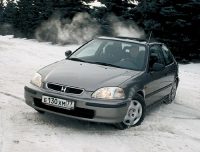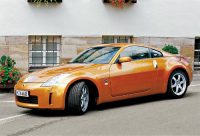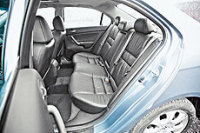Honda Civic: Everything can CVT
 In front of me, it seems, a completely ordinary Honda Civic. At the stern – plates “1,6iEC” and “VTEC”. Everything is clear – the engine capacity of 1.6 liters with a mechanism for changing the height of the valves. Get in the car. Two pedals and a selector are also familiar to anyone who is familiar with the “automatic”.
In front of me, it seems, a completely ordinary Honda Civic. At the stern – plates “1,6iEC” and “VTEC”. Everything is clear – the engine capacity of 1.6 liters with a mechanism for changing the height of the valves. Get in the car. Two pedals and a selector are also familiar to anyone who is familiar with the “automatic”.
I let the engine, taxiing to the avenue and “stepping” on the accelerator. And here miracles begin …
The tachometer needle, jumping up to 4000 rpm, as if stuck to this mark – taking the note, the motor holds it without getting lost. The car, know yourself, accelerates and accelerates, powerfully and, what is most striking, absolutely evenly, without a hint of jerks that accompany the gear shift, even in a good “machine.” Something very familiar is in such a smooth acceleration … Well, of course! After all, it is typically “trolleybus”!
In the meantime, a red eye of a traffic light appeared in front of us – there is nothing to do, I attach myself behind some kind of “nine”. Well, it’s time to open the cards.
The fact is that on my “Honda” is not a hydromechanical automatic transmission, but a continuously variable CVT (Continuously Variable Transmission). Yes, the usual V-belt variator. Although about the “usual” – I got excited. It is in many ways unusual. However, let’s not rush – to the place of the main tests still go and go. First, a little theory.
For any internal combustion engine, the maximum values of power, torque and minimum specific fuel consumption are achieved only at strictly defined revolutions. When overclocking, on each gear, the motor works with the greatest efficiency only in some moments, “skipping” the maximums of its characteristics. In addition, each switch, not to mention the loss of time, is accompanied by a longitudinal jerk – there is no traction on the drive wheels when the clutch is depressed.
The situation is somewhat better with automatic transmissions. The torque converter allows you to not interrupt the flow of power supplied to the wheels, and smoothly change the gear ratio, although in a fairly narrow range – on average from 1 to 2. At the same time, a small transformation ratio did not allow the “automatic” to completely abandon the step change gear numbers
There is a third solution. About him, and will be discussed. It is the mentioned stepless variator smoothly changing the gear ratio. The most famous is the V-belt. The principle of its action is clear from the figure. If you push or move the two plate-shaped pulley halves, the V-belt will either “fall” by a small contact radius, or “be forced out” by a large one. Usually, the belt connects two such pulleys working in “antiphase” (that is, one moves and the other moves apart). As a result, the range of gear ratios expands and there is no need for an additional tension roller.
Klinoremennye variators are widely used on motorcycle scooters and snowmobiles, but on cars they did not immediately take root. And for good reason. The clutch pulley and belt occurs only due to friction, and to increase it to transfer high power, it is necessary to tighten the belt more. This greatly reduces its resource. On a fifty-cubic scooter, a rubber strap “walks” 10-15 thousand kilometers, and on a “liter” snowmobile – several times less. But the latter is still, rather, a toy, and the mileage for the season is usually small. The car is another matter – here the annual mileage is sometimes tens of thousands of kilometers, and the power of the motors is higher. Who wants to change an expensive belt several times a year, and even with a gearbox disassembly?
Engineers at the Hamamatsu plant used a steel pusher design that was used on both the Ford Fiesta, FIAT Uno and Panda, and a number of other models. The Honda Civic strap is made up of 1.5 mm thick steel trapezoidal segments, in the side grooves of which on both sides there are 12 rings each made of flexible steel tape. When asked about the resource, Honda representatives modestly replied that they “had some problems with this until they picked up the right materials.”
Not satisfied with the verbal certificate, which, as you know, you cannot get down to business, I was not too lazy to look into the service book of the test Civic. Surprisingly, but a fact: every 20 thousand km provides only a general check of the variator, as well as brakes, steering gear, headlights, tires and much more. There is no replacement of the belt for 200 thousand km, for which all service operations are described. So that the belt resource is equal to that of the engine, the body and the usual gearbox. Well, now, theoretically, having been “grounded”, one can proceed to practice. Especially because of the conversations we have already reached the goal – a deserted country highway.
Transmission control with a CVT does not differ from the “automatic”: foot on the brake, the selector from position “P” to “D”. You release the brake – the car starts to creep forward (the multidisk clutch working in the oil bath allows slippage, therefore it switches on very gently), you add gas – it goes faster.



